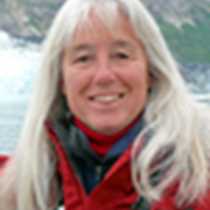National Geographic Sea Lion departed the dock in Juneau shortly after midnight and began our week-long photo expedition through Southeast Alaska. Heading south, we turned into Endicott Arm and motored about thirty miles to the immense Dawes Glacier at the head of the fjord. Along the way we marveled at the spectacular scenery and birdlife. Then we spotted a black bear eating barnacles along the shoreline and we turned to take a closer look. It was unperturbed as our shutters clicked and we viewed this beautiful animal from the safety of our vessel.
Small icebergs foreshadowed what lay ahead. Dawes glacier tumbles from the Stikine icefield to below sea level. At irregular and unpredictable intervals, pieces of ice of all sizes break off the face and fell into the water. We saw a few of these as we viewed the glacier from the bow of the ship. Large calvings deserve the descriptive term of “white thunder”, with a big splash accompanied by a tremendous roar. Only the most patient among us witnessed this from the stern of the ship as we pulled away. Bare rock above the sides and near the glacier front testifies to recent thinning and recession of the river of ice.
Harbor seals haul out on the icebergs to bear their pups, safe from land predators such as wolves and bears. Killer whales don’t like the noise of the ice and the silty water, so the icebergs provide good habitat for the seals, who don’t feel the cold through their thick layer of insulation. One young pup struggled franticly trying to climb onto the ice beside its mother. Claws at the tips of their flippers help them pull themselves onto the ice.
We had many chances to practice using binoculars as well as cameras. Mountain goats on the steep slopes provided a good challenge - very rewarding with perseverance.
As we retraced our way back down the fjord, we commenced with staff introductions and shore operation briefings in the lounge. Steve gave an introductory photo presentation entitled “A Positive View of Photography”, followed by break-out sessions with more specific information.
Just as the summer solstice moment occurred (2:34 P.M. Alaska time – the earliest in 120 years), we boarded our expedition landing crafts and ventured through the narrows of Ford’s Terror. Tidal timing has to be just right to be able to do this. We had a short window of time to do two rounds of expedition landing craft tours during slack tide before the narrow passage turned into a maelstrom of whitewater. Inside was a scenic wonderland of cascading waterfalls and precipitous rock walls. Photo opportunities abounded. Harbor porpoises, a seal mom and pup, harlequin ducks and a porcupine were some of the wildlife we observed. One highlight was an American dipper that caught a fish at the base of a waterfall! Wildflowers added splotches of red, yellow and creamy white to the many shades of green vegetation.
Back on board we gathered in the lounge for hors d’oeuvres, cocktails, and a recap of the day, followed by dinner. After desert, National Geographic photographer, Michael Melford, taught us about his favorite light conditions, showing us examples through a photographic presentation. Then we took advantage of the light, on this longest day of the year in the northern hemisphere, to enjoy amazing humpback whale activity near the ship. Welcome to summer!







